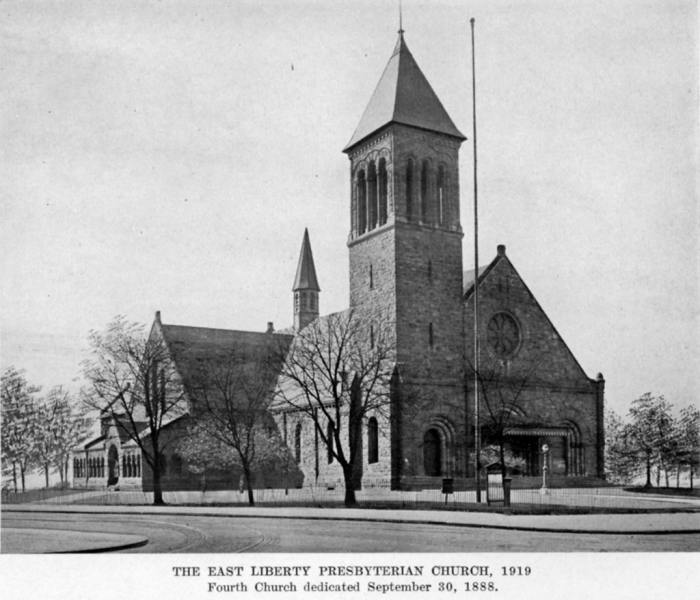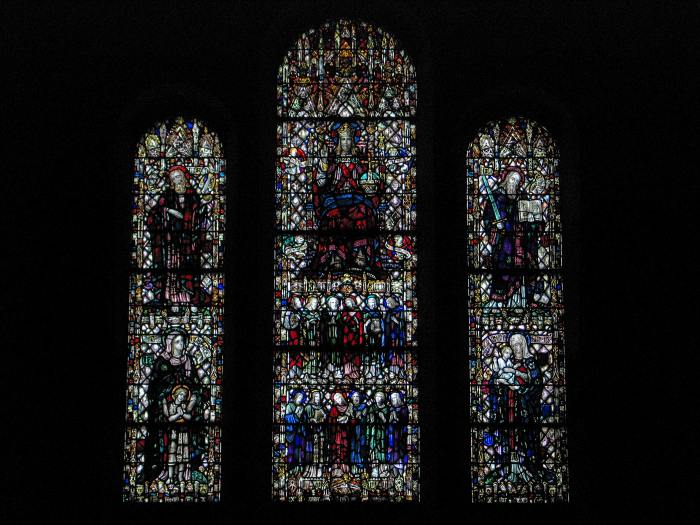
Henry Wynd Young (1874-1923), New York
Henry Wynd Young (1874-1923), New York: “Christ Enthroned,” c. 1922, Chapel chancel window in East Liberty Presbyterian Church; Ralph Adams Cram for Cram & Ferguson. Window originally installed in a transept of the previous building, Longfellow, Alden & Harlow (1886-88), architects
Photograph of “Christ Enthroned” and text copyright © 2007 Pittsburgh History & Landmarks Foundation
One of the finest stained glass windows in Pittsburgh, designed and made by one of the most gifted glass artists working in 20th-century America, is only intermittently visible. Located in the chapel of East Liberty Presbyterian Church, it is obscured by liturgical banners only removed for special occasions such as weddings, concerts, and funerals. The name of the window and its precise date are as yet unknown. For convenience sake we will call it “Christ Enthroned,” note that the design was exhibited in Pittsburgh in 1922, and that the window was installed in a transept in the 1888 church building, demolished in 1931 to make way for the current building designed by Ralph Adams Cram.
Scottish stained glass artist and historian Rona H. Moody has determined that Henry Wynd Young was born in Bannockburn, Scotland, in 1874, was living in Aberdeen by 1881, and attended evening classes at Gray’s School of Art there 1889-c. 1896. A decade later—a decade presumably spent working in glass firms (as yet unidentified)—Young arrived in New York on May 10, 1907; his wife Bessie and year-old son Henry Walter left Aberdeen and came to the United States, arriving New York on November 6, 1907. A second son, Alexander, was born in New York City in 1908. Young and his family settled in Brooklyn where he established his own business.
Young exhibited some of his designs at the Architectural League of New York in 1914. The following year he formed a partnership with G. Owen Bonawit (1890-1971). Fellow Scot John Gordon Guthrie (1874-1961) joined the firm that year and subsequently they were joined by Irish glazer Ernest Lakeman (1882-1948). The Bonawit & Young partnership dissolved in 1918. Young moved his residence to Hamilton, New York; he died there on December 25, 1923. Guthrie stayed on until 1925 and Lakeman operated Young’s glass shop for several years thereafter. According to the 1930 census, Bessie T. Young was president of the firm and Henry Walter Young worked there as a stained glass painter.
In 1919 Bertram Goodhue wrote of Young: “there is no doubt in my mind that he is far and away the best glass stainer we have.” Ralph Adams Cram thought so highly of Young’s work that he included him posthumously in his 1924 survey of the best stained glass firms then working in America. Windows by Young can be found, most notably, at St. Paul’s Chapel, Columbia University, the Cathedral of St. John the Divine, and St. Vincent Ferrer in New York City; Emmanuel Church, Newport, R.I.; Church of the Redeemer, Morristown, New Jersey; and East Liberty Presbyterian Church.
In 1922 Young participated in an exhibition of stained glass organized by Lawrence B. Saint (a Pittsburgh glass artist who established the Washington National Cathedral’s stained glass studio in 1928)—Stained Glass: Original Windows, Designs, Cartoons, Drawings of Medieval Windows, held November 13-December 16, 1922 at the Carnegie Institute in Pittsburgh. One of the items Young exhibited was “Sketch design of transept, East Liberty Presbyterian Church, Pittsburgh, Pennsylvania.” The finished window, left to right, shows Old Testament figures Elijah above and Hannah and her son Samuel below; Christ enthroned above the twelve apostles in the center; and, from the New Testament, St. Paul above and Mary and the infant Jesus below.
There is as yet no comprehensive assessment of Young’s work. The iconography and the colors of his windows evoke medieval English glass while displaying “a wry and sophisticated sense of character,” in James Sturm’s apt phrase. Young operated a small shop, assisted by a few gifted associates, a practice influenced by the Arts and Crafts movement in Britain. Charles J. Connick, educated and trained in Pittsburgh, advocated an Arts and Crafts approach in his Boston studio. He wrote of Young:
The late Henry Wynd Young re-created with sensitiveness and charm the forms familiar to students of fifteenth-century glass in England. He was searched out by appreciative architects and churchmen who were not satisfied by advertisers and salesmen. Through opportunities they gave him he has left us a few examples of exquisite windows . . . . He helped to make a place in America for the artist-craftsman who need not be heralded by salesmen and publicity agents.
Sources: Bertram G. Goodhue correspondence 1903-24, Avery Architectural and Fine Arts library, Columbia University. Ralph Adams Cram, “Stained Glass: An Art Restored; America’s Position in Bringing About a Renaissance of This Phase of Architectural Beauty,” Arts and Decoration 20 (February 1924): 11-13, 50. Charles J. Connick, Adventures in Light and Color (New York 1937): 176. James L. Sturm, Stained Glass From Medieval Times to the Present: Treasures to Be Seen in New York (New York 1982): 72. Special thanks to Peter Cormack, Rona H. Moody, and Wayne H. Kempton, Archivist, Episcopal Diocese of New York.
Illustrations
- East Liberty Presbyterian Church (1888-1931). Photograph taken from Georgina G. Negley, East Liberty Presbyterian Church (Pittsburgh 1919): following page 118.
- “Christ Enthroned”


